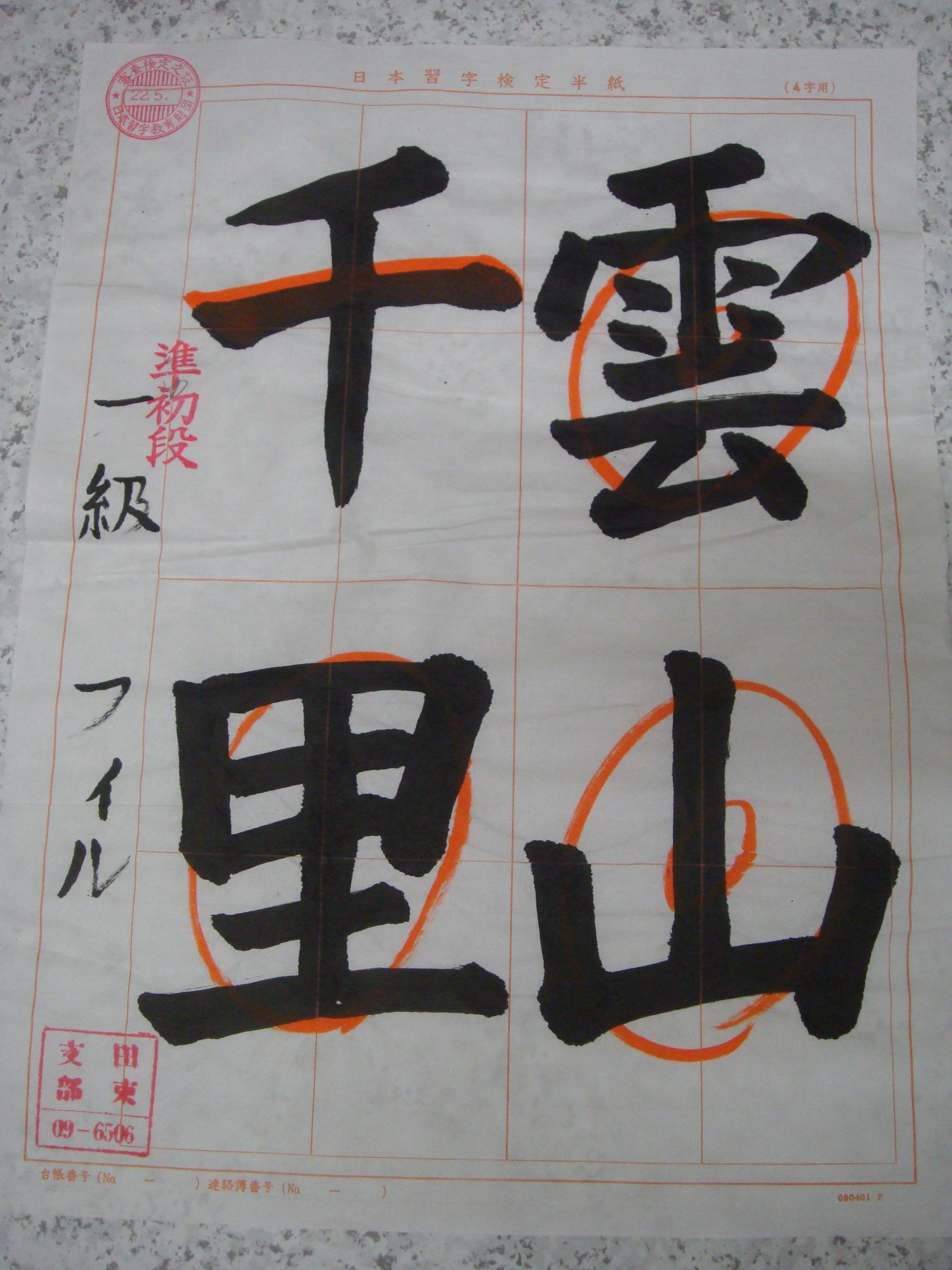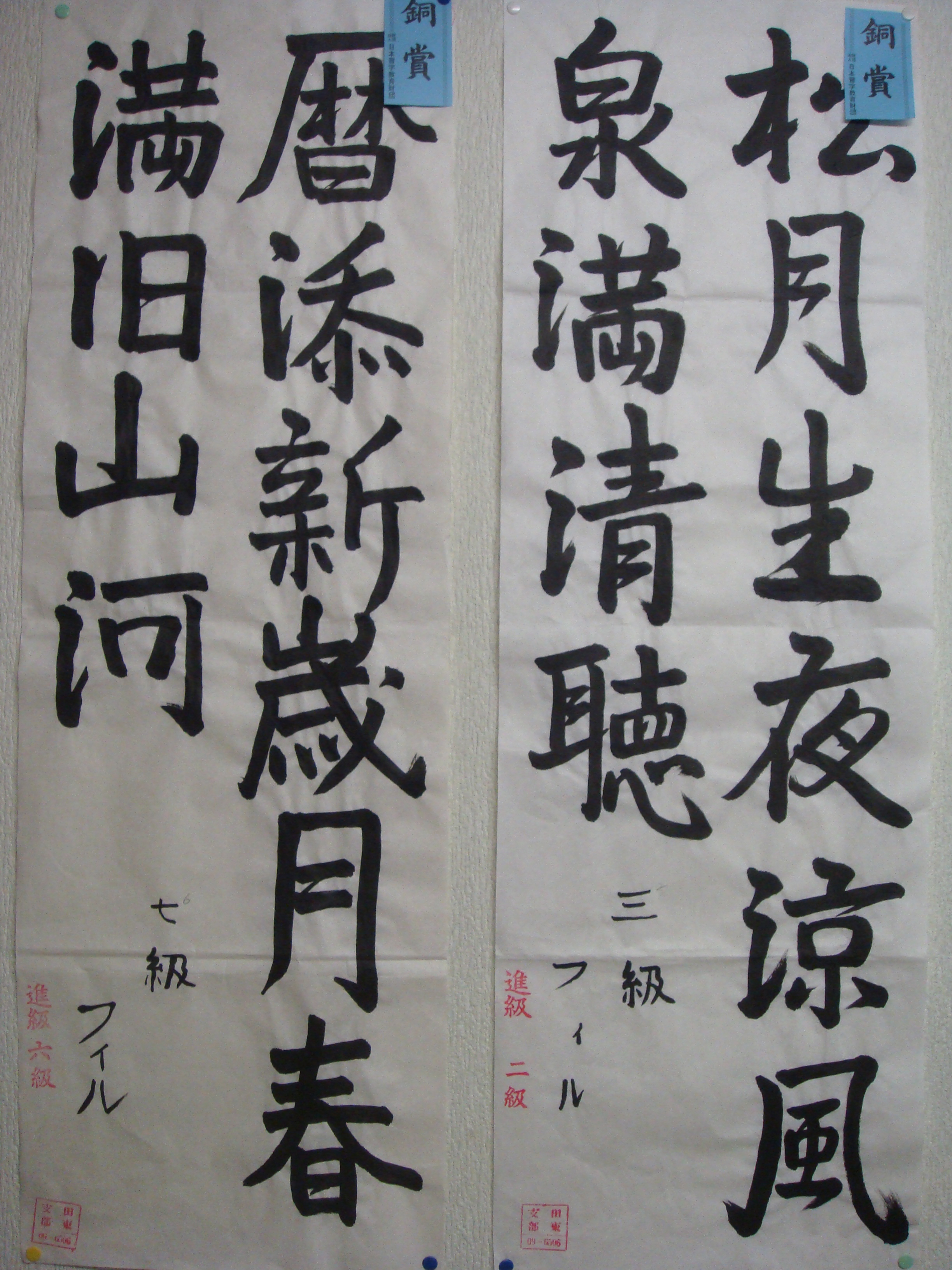What is 習字 (shuji)?
Shuji (Japanese calligraphy) is the skillful writing of kanji characters in a way that gives them balance and expression. It is not just writing a character on a piece of paper though. It is much more than that. Each stroke has a a proper way to begin and end and there is a correct order and path to follow. It takes lots of time and practice to master, and it’s essential to focus. The slightest lapse in concentration will show in one’s work.
Calligraphy was introduced in Japan around 600 AD, but dates back to the BC era in China. It is now a required subject in elementary and junior high school in Japan, as part of the Japanese language curriculum. In high school it is offered as an art course. It can be difficult for the untrained eye to appreciate the delicate curves of each stroke or the intricacies and subtle beauty of the perfect stop, both of which contribute to the proper balance of each character.
The following are the few items needed to practice shuji:
- calligraphy brush (筆, fude)
- calligraphy ink, available already in liquid form or as a stick (墨, sumi)
- inkstone, to grind the ink stick on (硯, suzuri)
- Japanese washi paper, not rice paper (和紙, washi)
- felt mat (下敷, shitajiki)
- paperweight (文鎮, bunchin)
There are three styles to Japanese calligraphy writing: block printed style (楷書, kaisho), semi-cursive style (行書, gyosho), and cursive style (草書, sosho). All learners of shuji begin with the block printed style and work their way up toward the more difficult styles.
What I’ve Been Doing
I wanted to learn one of Japan’s traditional art forms while I was here, and shuji seemed like the perfect fit. I’ve always had an interest in the arts (it runs in the family), but I’ve never had the patience or time to fully develop this interest. Shuji combines my interests in Japan along with fine art excellently.
Since November of 2008 I have been studying shuji from one of my neighbors, a level 8 shuji master (the highest rank), and I have been slowly progressing toward my goal of reaching the sho-dan level (level 1 master). Every Wednesday night, I take a stroll down the street to his house for instruction and practice. At the beginning of each lesson, I’ll warm up by doing some basic strokes, then practice 3-5 pages of characters for this month’s test. My sensei will then mark the strokes where I need to practice more in orange ink. He always tells me with a chuckle and a smile, “Doushite mo migi agari ga tarinai na,” (no matter what, your rightward strokes never rise up enough!). At the end of the month I do a test paper, which my sensei mails to the Japan Calligraphy Education Foundation (日本習字, JCEF) headquarters in Kyoto for grading. The tests are marked, graded, and returned within a few weeks. The JCEF will stamp your test paper if you have passed to the next level when they return it. I am currently at the jun sho-dan level (pre-level 1 master), with one more level to go in order to reach my goal of sho-dan (level 1 master).
Reaching for Goals
Japanese calligraphy uses the same kyu/dan (beginner/master) ranking system that’s used in other traditional Japanese art forms, such as martial arts. The kyu ranks count inversely up to the dan ranks, meaning that one starts at 10-kyu and moves up all the way to 1-kyu, then jun sho-dan (pre-level 1 master), sho-dan (level 1 master), 2-dan, and so on all the way up to 8-dan, the highest ranking one can receive. Getting a sho-dan ranking is the equivalent of getting your black belt in karate- there is still a way up to go from there, but it is a first-level master. With the sho-dan ranking comes a certificate stating that you are able to teach beginners shuji. For now, I’m waiting for the results from my last test paper. I’m heading back to the States in August, and time is running out on reaching sho-dan…



すげぇ。I hope you continue once back in the States. Very slick blog, too, I’m really impressed!
Thanks Kevin! I want to keep doing it when I get back to the States- might need to find a sensei though…
Where in the states? there are Senseis in many states, NY, NJ for sure.
Arlington, virginia!
I vaguely remember finding a Sensei there while looking for one in NYC/NJ. I am sorry I can not remember where I found that.
Hi, Phillip-san
Both Nao and I have gone through the similar ranking system. Our schools are not as popular as nihon shuji.
I like your explanation about shuji. It’s easy to understand and precise.
Hey Alice,
What school are you guys going through?
Hello.
Nao belongs to shodogakusyusha (書道学習社). I used to learn at fukubokukai (復朴会). Both schools are based on Nagoya, Aichi.
Our teacher is our aunt, who got a Nitten prize twice.
-> http://www.nitten.or.jp/english/index.html
Wow, that’s pretty impressive about your aunt. Very cool.
Pingback: Japanese Calligraphy Update: Sho-dan « The Blog of Phillip Sauvé
Pingback: Japanese Calligraphy: In the regional newspaper for calligraphy work « The Blog of Phillip Sauvé
Pingback: In the regional newspaper for calligraphy work « The Blog of Phillip Sauvé
Thank you! It was very useful infos.
I would like to know how can i join into JCEF in order to receive the work to practise and be graded my work?
It’s impressive. I am born and raised in Japan but you have a better Shuji skill than me! I’m sure you practice hard to earn it. If you come to the USA, I am sure you will be appreciated to involve in school events such as Great American teach-in to share your skills and knowledge. I am a mom of two and doing this tomorrow at my kids school as a volunteer. Good luck and enjoy your life in Japan (if you are still there)!
Megumi, good luck at your kids school- I hope the presentation goes well! Thank you for sharing about the Great American teach-in; I had never heard of this before, but it sounds like a great idea!
Hi, Phillip,
I really enjoyed your blog. I am so impressed with your calligraphy. You are like a native Japanese. How long did you live in Japan? I was wondering if you are continuing with your shuji / shodo studies in Arlington, VA?
All the best!
Thanks for visiting! I lived there for three years and had a wonderful time. I have been a bit negligent about practicing shuji as of late :/ I tried to get a county adult ed shuji course started when I first returned from Japan, but kept falling one or two students short of the class minimum. Maybe I’ll try again soon!
I’m surprised. I would think since such classes are so hard to come by you’d have students lining up. If I still lived in Virginia, I’d definitely sign up. I just signed up for a shodo class here in southern California. Our sensei flies in from Oregon once a month if you can believe that. I’m a little intimidated but really looking forward to it.
All the best!
Flies in from Oregon just for the class- that sounds intense! Good luck!
Pingback: ウソツキ!ゴクオーくん 第2・3話 | Karl Andersson